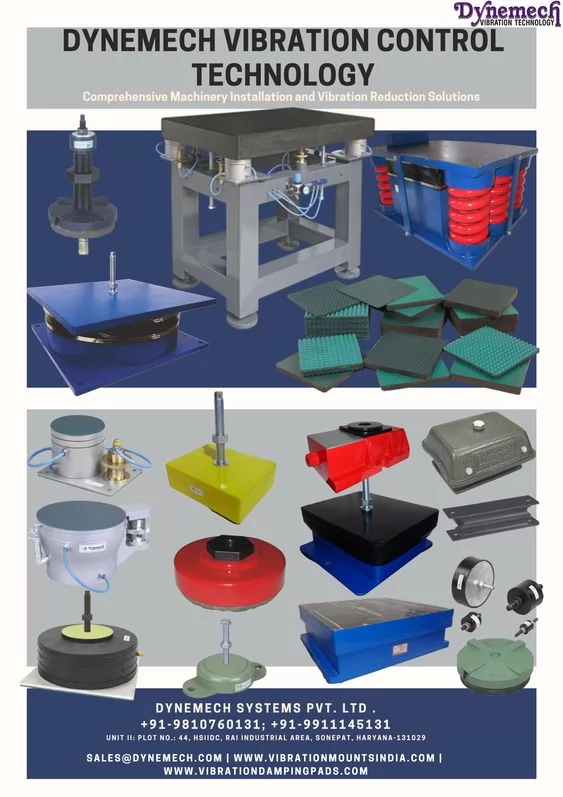Machinery vibration can be a problem in industrial settings as it can lead to excessive noise, reduced efficiency, and even damage to equipment over time. Fortunately, there are several techniques that can be used to reduce vibration, including anti-vibration pads. In this blog, we’ll compare anti-vibration pads with other vibration reduction techniques and help you determine which method is best for your specific needs.
What Are Anti-Vibration Pads?
Anti-vibration pads are designed to reduce the vibrations that occur when a machine is in use. These pads are typically made of rubber, neoprene, or cork, and they are placed between the machine and the floor. By absorbing the energy generated by the machine’s vibrations, these pads can help to reduce the noise and vibrations that are produced. Anti-vibration pads come in a variety of shapes and sizes, so they can be customized to fit the specific needs of your machinery. They are relatively easy to install and are a cost-effective solution for reducing vibration in many different types of equipment.

Other Vibration Reduction Techniques
While anti-vibration pads are a popular choice for reducing machine vibration, there are several other techniques that can be used as well. Let’s take a look at some of the most common methods:
Dynamic Balancing
Dynamic balancing is a technique used to balance rotating equipment, such as fans, motors, and pumps. By balancing the rotating parts, the vibration can be significantly reduced. This technique involves adding or removing weight from the rotating parts to achieve a balanced state. While dynamic balancing can be effective in reducing vibration, it can be time-consuming and expensive. It also requires specialized equipment and expertise to perform properly.
Dampers
Dampers are devices that are installed on machinery to absorb the energy created by vibration. These devices are typically made of metal or rubber and are placed between the moving parts of the machinery. When the machinery is in use, the dampers absorb the energy created by vibration and help to reduce the overall vibration. Dampers can be effective in reducing vibration, but they can be expensive and difficult to install. They also require regular maintenance to ensure that they are working properly.
Isolators
Isolators are devices that are designed to isolate machinery from the floor or foundation. These devices are typically made of rubber or other elastomers and are placed between the machine and the floor. By isolating the machine from the floor, the vibrations are reduced. Isolators can be effective in reducing vibration, but they can be expensive and difficult to install. They also require regular maintenance to ensure that they are working properly.
Anti-Vibration Pads vs. Other Vibration Reduction Techniques
Now that we’ve discussed some of the most common vibration reduction techniques, let’s compare them to anti-vibration pads.
Cost
Anti-vibration pads are generally less expensive than other vibration reduction techniques. They are easy to install and require little maintenance, which makes them a cost-effective solution for reducing vibration.
Effectiveness
While other vibration reduction techniques can be effective in reducing vibration, anti-vibration pads are typically more effective. This is because they absorb the energy generated by vibration, which helps to reduce the overall vibration.
Ease of Installation
Anti-vibration pads are relatively easy to install and require no specialized equipment or expertise. Other vibration reduction techniques, such as dynamic balancing and isolators, require specialized equipment and expertise to install properly.
Maintenance
Anti-vibration pads require very little maintenance, while other vibration reduction techniques require regular maintenance to ensure that they are working properly.
Customization
Anti-vibration pads can be customized to fit the specific needs of your machinery. Other vibration reduction techniques, such as dampers and isolators, are typically one-size-fits-all solutions.
So, which method is better? The answer depends on the specific needs of your machinery and your budget. Anti-vibration pads are a cost-effective and easy-to-install solution for reducing vibration in many different types of equipment. If your machinery requires more specialized solutions, however, other vibration reduction techniques may be necessary.
For example, if your machinery is rotating equipment like a fan or a motor, dynamic balancing may be the best solution. If your machinery is heavy and requires isolation from the floor or foundation, isolators may be the best option.
It’s important to note that different vibration reduction techniques can also be used in combination with each other. For example, anti-vibration pads can be used in conjunction with dampers or isolators to achieve the best possible results.
Ultimately, the best way to determine which vibration reduction technique is right for your machinery is to consult with a professional. A vibration specialist can assess your machinery and recommend the best solution for your specific needs.
Conclusion
Reducing vibration in machinery is important for improving efficiency, reducing noise, and preventing damage to equipment over time. While there are several different vibration reduction techniques available, anti-vibration pads are a cost-effective and easy-to-install solution for many different types of equipment.
When deciding on a vibration reduction solution, it’s important to consider factors like cost, effectiveness, ease of installation, maintenance, and customization. A professional vibration specialist can help you determine which technique is best for your machinery and your budget.
At Dynemech Systems, we specialize in manufacturing high-quality Anti-vibration pads and other vibration reduction solutions. Our team of experts can help you determine the best solution for your specific needs and provide the support you need to keep your machinery running smoothly. Contact us today to learn more.
